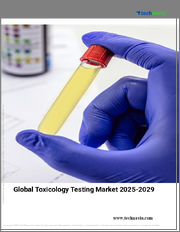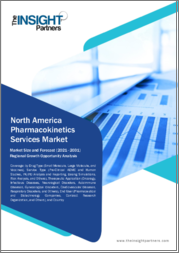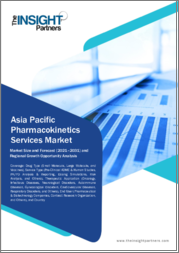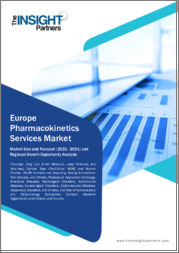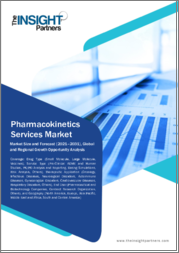
|
시장보고서
상품코드
1717871
약동학 서비스 시장 : 유형별, 서비스 유형별, 최종사용자별 - 세계 예측(2025-2030년)Pharmacokinetics Services Market by Type, Service Type, End-User - Global Forecast 2025-2030 |
||||||
약동학 서비스 시장은 2024년에 11억 9,000만 달러로 평가되었으며, 2025년에는 13억 달러, CAGR 9.03%로 성장하여 2030년에는 20억 1,000만 달러에 달할 것으로 예측됩니다.
| 주요 시장 통계 | |
|---|---|
| 기준 연도 2024년 | 11억 9,000만 달러 |
| 추정 연도 2025년 | 13억 달러 |
| 예측 연도 2030년 | 20억 1,000만 달러 |
| CAGR(%) | 9.03% |
약동학 서비스 시장은 새로운 기술, 복잡한 의약품 개발 과제, 효율적인 치료 솔루션에 대한 세계 수요 증가에 힘입어 큰 진화를 거듭하고 있습니다. 약물의 흡수, 분포, 대사, 배설을 정확하게 측정하는 것이 가장 중요한 상황에서 업계 관계자들은 새로운 기회를 활용하고 새로운 장애물에 대처하기 위해 전략을 재조정하고 있습니다. 최근 분석법의 발전과 새로운 치료제의 출현으로 임상 연구 및 규제 준수에 대한 민첩한 접근이 요구되고 있습니다.
약동학 서비스는 정확한 데이터 수집과 시기적절한 개입 전략을 통해 투여 요법을 최적화하고 환자의 안전성을 높이기 위한 정확한 데이터 수집과 적시 개입 전략을 가능하게함으로써 현재 신약 개발 및 개발에 중요한 역할을 하고 있습니다. 이 역동적인 분야에서는 최첨단 체외 및 생체 내 시험과 첨단 계산 모델링을 결합한 통합 서비스 제공이 급증하고 있습니다. 조직이 이러한 복잡한 지형에서 살아남기 위해서는 전략적 혁신이 필수적이며, 광범위한 치료 영역에서 확실한 성과와 경쟁적 차별화를 확보해야 합니다.
정교한 장비와 디지털 분석의 도입은 약동학의 전략적 중요성을 더욱 높여 제약 및 생명공학 산업에서 필수적인 요소로 자리 잡았습니다. 따라서 이해관계자들은 약물 평가의 속도와 정확성을 향상시킬 뿐만 아니라 진화하는 세계 규제 표준을 준수하기 위해 R&D 이니셔티브에 많은 투자를 하고 있습니다. 현재의 시장 역학은 첨단 기술에 대한 투자와 공동 연구 기회를 찾는 것이 이 분야의 지속적인 성장과 성공의 핵심임을 시사하고 있습니다.
약동학 정세를 형성하는 변혁적 변화
약동학 서비스 분야는 급속한 기술 발전과 진화하는 고객 요구사항으로 인해 혁신적인 변화가 일어나고 있습니다. 최근 몇 년 동안 자동화 시스템과 디지털 데이터 플랫폼의 광범위한 통합은 전통적인 업무를 재정의하고 의약품 평가에 대한 보다 종합적인 접근 방식을 가능하게 했습니다. 혁신적인 기술에 대한 투자는 수작업으로 인한 실수를 최소화하고, 재현성을 향상시키며, 최신 규제 프레임워크의 엄격한 요구 사항을 충족하는 실시간 데이터 분석을 가능하게 합니다.
또한, 바이오의약품의 기술 혁신과 첨단 분석의 결합은 맞춤형 의료로의 전환을 가져왔습니다. 이러한 전환은 단순한 기술적 도입에 그치지 않고 다양한 환자 집단에서 약동학에 대한 이해를 미세 조정하는 보다 광범위한 전략적 노력을 반영하고 있습니다. 업계가 적응함에 따라 in-vitro와 in-vivo 방법론을 통합하는 솔루션의 중요성이 커지고 있으며, 임상 결과를 최적화하기 위해 다양한 연구 모델의 통합이 절실히 요구되고 있습니다.
이 급격한 변화의 시기는 의약품 개발의 라이프사이클을 가속화하는 동시에 안전성과 유효성을 극대화하는 데 초점을 맞추고 있습니다. 새로운 연구 프로토콜은 강화된 시뮬레이션 플랫폼과 함께 연구자들이 전례 없는 정확도로 약물의 거동을 예측할 수 있게 해줍니다. 이러한 발전은 연구기관, 기술 파트너, 규제기관 간의 기능 간 협력을 촉진하고, 궁극적으로 데이터 기반 혁신이 신약 및 치료제 개발의 판도를 뒤바꿀 수 있는 환경을 조성하고 있습니다.
시장 세분화를 통한 인사이트으로 시장 성장을 노립니다.
세심한 세분화 분석을 통해 약동학 서비스 시장의 이질적인 성격을 명확히 하고 성장 잠재력이 있는 분야를 파악할 수 있습니다. 시장 분석은 주로 유형, 서비스 유형, 최종사용자 속성에 따라 분류됩니다. 유형별로 분류하면, 시장은 전통적으로 고분자 약동학 서비스와 저분자 약동학 서비스로 나뉩니다. 생물학적 제제나 치료용 단백질과 같은 고분자는 복잡한 구조로 인해 약동학 평가에서 고도의 전문적 취급이 요구되는 반면, 저분자는 반복적인 방법론의 강화로 혜택을 받을 수 있는 고전적 분석 문제를 야기합니다.
또한, 서비스 유형별 세분화는 in-vitro와 in-vivo 시험이라는 업계의 이중적 초점을 강조하고 있으며, in-vitro 부문은 초기 단계의 약물 평가를 위해 통제된 조건을 제공하는 실험실 기반 실험으로 시간 효율적이고 비용 효율적인 인사이트를 제공합니다. 시간 효율적이고 비용 효율적인 인사이트를 제공합니다. 반면, in-vivo 시험은 살아있는 피험자의 약물 거동을 평가하여 치료제의 종합적인 약동학 프로파일을 이해하는 데 필수적인 실제 관점을 제공합니다. 이 두 가지 서비스를 제공할 수 있게 됨으로써 시장 개척 기업은 의약품 개발의 전체 라이프사이클에 대응하는 솔루션 세트를 제공할 수 있게 되었습니다.
최종사용자별로 세분화하면 수요 측면의 다양성과 복잡성이 더욱 부각됩니다. 시장에는 학계 및 정부 연구기관부터 생명공학 기업, 의약품 개발 위탁기관, 대형 제약회사에 이르기까지 다양한 고객이 존재합니다. 각 분야마다 고유한 과제와 요구사항이 있으며, 연구와 서비스 제공에 있어 각 분야에 맞는 접근 방식이 필요합니다. 기술 혁신가, 학술 기관, 영리 기업들은 규제와 시장의 기대에 부응하는 연구에 집중하기 위해 연구 전략에 대한 협업을 강화하고 있습니다. 이러한 다면적인 세분화 프레임워크를 통해 서비스 제공업체는 리소스 할당을 최적화하고, 연구 방법을 조정하고, 궁극적으로 고객의 요구와 시장 제공 간의 더 나은 조정을 달성할 수 있습니다. 이러한 세분화를 통해 얻은 전략적 인사이트는 신흥 시장 동향과 고객 요구 사항을 제품 개발 및 시장 개발 전략과 일치시키는 데 도움이 될 수 있습니다.
목차
제1장 서문
제2장 조사 방법
제3장 주요 요약
제4장 시장 개요
제5장 시장 인사이트
- 시장 역학
- 성장 촉진요인
- 성장 억제요인
- 기회
- 해결해야 할 과제
- 시장 세분화 분석
- Porter’s Five Forces 분석
- PESTLE 분석
- 정치
- 경제
- 사회
- 기술
- 법률
- 환경
제6장 약동학 서비스 시장 : 유형별
- 거대 분자 약동학 서비스
- 소분자 약동학 서비스
제7장 약동학 서비스 시장 : 서비스 유형별
- 체외
- 생체내
제8장 약동학 서비스 시장 : 최종사용자별
- 학술기관 및 정부 조사기관
- 바이오테크놀러지 기업
- 임상시험수탁기관
- 제약회사
제9장 아메리카의 약동학 서비스 시장
- 아르헨티나
- 브라질
- 캐나다
- 멕시코
- 미국
제10장 아시아태평양의 약동학 서비스 시장
- 호주
- 중국
- 인도
- 인도네시아
- 일본
- 말레이시아
- 필리핀
- 싱가포르
- 한국
- 대만
- 태국
- 베트남
제11장 유럽, 중동 및 아프리카의 약동학 서비스 시장
- 덴마크
- 이집트
- 핀란드
- 프랑스
- 독일
- 이스라엘
- 이탈리아
- 네덜란드
- 나이지리아
- 노르웨이
- 폴란드
- 카타르
- 러시아
- 사우디아라비아
- 남아프리카공화국
- 스페인
- 스웨덴
- 스위스
- 튀르키예
- 아랍에미리트
- 영국
제12장 경쟁 구도
- 시장 점유율 분석, 2024
- FPNV 포지셔닝 매트릭스, 2024
- 경쟁 시나리오 분석
- 전략 분석과 제안
기업 리스트
- Absorption Systems LLC
- Allucent
- Aurigene Pharmaceutical Services Ltd.
- Certara
- Charles River Laboratories, Inc.
- Creative Bioarray
- Eurofins Scientific SE
- Evotec SE
- Frontage Laboratories, Inc.
- ICON PLC
- Laboratory Corporation of America Holdings
- LGC Limited by Cinven
- NUVISAN Pharma Holding GmbH
- Pacific BioLabs
- Parexel International(MA) Corporation
- Pfizer Inc.
- PPD Inc. by Thermo Fisher Scientific Inc.
- Premier Consulting
- Reaction Biology Corporation
- SGS SA
- Svar Life Science AB
- WuXi AppTec Co., Ltd.
- XenoTech by BioIVT
- Xyzagen
The Pharmacokinetics Services Market was valued at USD 1.19 billion in 2024 and is projected to grow to USD 1.30 billion in 2025, with a CAGR of 9.03%, reaching USD 2.01 billion by 2030.
| KEY MARKET STATISTICS | |
|---|---|
| Base Year [2024] | USD 1.19 billion |
| Estimated Year [2025] | USD 1.30 billion |
| Forecast Year [2030] | USD 2.01 billion |
| CAGR (%) | 9.03% |
The pharmacokinetics services market is on the cusp of significant evolution, driven by emerging technologies, complex drug development challenges, and an ever-growing global demand for efficient therapeutic solutions. In a landscape where the accurate measurement of drug absorption, distribution, metabolism, and excretion is paramount, industry stakeholders are refining their strategies to harness new opportunities and address emerging impediments. Recent advancements in analytical methods and the advent of novel therapeutic agents have also necessitated an agile approach in clinical research and regulatory compliance.
Pharmacokinetics services now play a critical role in drug discovery and development by enabling precise data collection and timely intervention strategies that optimize dosing regimens and enhance patient safety. This dynamic field has witnessed a surge in integrated service offerings that combine state-of-the-art in-vitro and in-vivo studies with advanced computational modeling. As organizations navigate this complex terrain, strategic innovation remains a vital ingredient ensuring both robust results and competitive differentiation across a broad spectrum of therapeutic areas.
The introduction of sophisticated instrumentation and digital analytics has further elevated the strategic importance of pharmacokinetics, making it an indispensable facet within the pharmaceutical and biotech industries. Stakeholders are, therefore, investing considerably in research and development initiatives to not only improve the speed and accuracy of drug assessment but also to maintain compliance with evolving global regulatory standards. The current market dynamics signal that investing in cutting-edge technologies and seeking collaborative opportunities will be central to the sustained growth and success of the sector.
Transformative Shifts Reshaping the Pharmacokinetics Landscape
The pharmacokinetics services arena is experiencing transformative shifts powered by rapid technological advancements and evolving customer demands. Over recent years, the widespread integration of automated systems and digital data platforms has redefined traditional practices and enabled a more holistic approach to drug evaluation. Investment in innovative technology has minimized manual errors, enhanced reproducibility, and allowed for real-time data analysis that meets the stringent demands of modern regulatory frameworks.
Furthermore, the convergence of biopharmaceutical innovation and advanced analytics has led to a transformative pivot towards personalized medicine. This shift is not merely about technological adoption but also reflects a broader strategic effort to fine-tune the understanding of drug dynamics in diverse patient populations. As the industry adapts, solutions that merge in-vitro and in-vivo methodologies are assuming greater significance, driving a much-needed integration of various study models to optimize clinical outcomes.
This period of radical transformation is also marked by a keen focus on accelerating the drug development life cycle while ensuring maximum safety and efficacy. New investigative protocols, coupled with enhanced simulation platforms, are allowing researchers to predict drug behavior with unprecedented accuracy. Such developments have encouraged cross-functional collaborations among research institutions, technology partners, and regulatory agencies, ultimately fostering an environment in which innovation driven by data is transforming the landscape of drug discovery and therapeutic development.
Key Segmentation Insights for Targeted Market Growth
A careful segmentation analysis provides a clear view of the heterogeneous nature of the pharmacokinetics services market, illuminating the areas that are primed for growth. The market analysis is primarily categorized based on type, service type, and end-user demographics. When examining the segmentation based on type, the market has been traditionally divided between offerings for large molecules pharmacokinetics services and small molecules pharmacokinetics services. In many cases, large molecules, such as biologics and therapeutic proteins, demand highly specialized handling during pharmacokinetic assessment due to their complex structure, while small molecules bring forward classic analytical challenges that continue to benefit from iterative methodological enhancements.
In addition, segmentation in terms of service type highlights the dual focus of the industry around in-vitro and in-vivo studies. The in-vitro segment represents laboratory-based experiments that provide controlled conditions for early-stage drug evaluation, offering time-efficient and cost-effective insights. Conversely, in-vivo studies bring an essential real-world perspective to the table by evaluating drug behavior in live subjects, which is indispensable for understanding the comprehensive pharmacokinetic profile of therapeutic agents. The ability to provide both types of services allows market players to offer a complete suite of solutions that cater to the complete lifecycle of drug development.
Further segmentation by end-user underscores the diversity and complexity of the demand side. The market landscape encompasses a wide array of clients ranging from academic and government research institutes to biotechnology companies, contract research organizations, and large-scale pharmaceutical companies. Each segment brings its unique challenges and requirements, necessitating a tailored approach to research and service delivery. Technology innovators, academic institutions, and commercial players are increasingly aligning their research strategies to focus on delivers that meet both regulatory and market expectations. This multifaceted segmentation framework enables service providers to optimize resource allocation, tailor their research methodologies, and ultimately achieve better alignment between client needs and market offerings. The strategic insights drawn from this segmentation are instrumental in aligning product development and marketing strategies with emerging trends and client demands.
Based on Type, market is studied across Large Molecules Pharmacokinetics Services and Small Molecules Pharmacokinetics Services.
Based on Service Type, market is studied across In-Vitro and In-Vivo.
Based on End-User, market is studied across Academic & Government Research Institutes, Biotechnology Companies, Contract Research Organizations, and Pharmaceutical Companies.
Emerging Regional Trends Shaping Market Dynamics
The pharmacokinetics services market is hugely influenced by regional trends that dictate regulatory frameworks, innovation capacities, and overall market dynamics. In the Americas, robust infrastructure and a highly developed network of research institutions foster a conducive environment for advanced pharmacokinetic investigations. This region benefits from well-established partnerships between academic and commercial entities, ensuring that the industry remains at the forefront of scientific breakthroughs and regulatory compliance.
Meanwhile, the combined region of Europe, Middle East, and Africa exhibits a diversified landscape where traditional research ecosystems meet emerging technological hubs. The interplay of different regulatory bodies within Europe and the growing innovation pockets in the Middle East and Africa have led to a flexible yet highly competitive environment. The region's diverse market conditions, varying from stringent regulatory oversight in Europe to more agile exploratory approaches in other parts, require service providers to adopt adaptable strategies that balance caution with innovation.
In Asia-Pacific, rapid economic growth combined with strong governmental support for pharmaceutical research has cemented the region's position as a key player in the global pharmacokinetics market. The emphasis on research and development, significant investments in biotechnology, and a surge in academic outputs have stimulated the demand for specialized pharmacokinetic services. The region benefits from a burgeoning talent pool and increased focus on integrating novel methodologies with traditional practices, setting the stage for accelerated market growth over the coming years. Overall, these regional insights point towards the need for global companies to adapt their strategies to cater to varying regional requirements while leveraging emerging trends for sustainable market expansion.
Based on Region, market is studied across Americas, Asia-Pacific, and Europe, Middle East & Africa. The Americas is further studied across Argentina, Brazil, Canada, Mexico, and United States. The United States is further studied across California, Florida, Illinois, New York, Ohio, Pennsylvania, and Texas. The Asia-Pacific is further studied across Australia, China, India, Indonesia, Japan, Malaysia, Philippines, Singapore, South Korea, Taiwan, Thailand, and Vietnam. The Europe, Middle East & Africa is further studied across Denmark, Egypt, Finland, France, Germany, Israel, Italy, Netherlands, Nigeria, Norway, Poland, Qatar, Russia, Saudi Arabia, South Africa, Spain, Sweden, Switzerland, Turkey, United Arab Emirates, and United Kingdom.
Insights on Leading Companies Driving Market Innovation
An analysis of the key companies active in the pharmacokinetics space reveals a competitive landscape where leaders are continuously pushing the boundaries of scientific innovation and service quality. Industry frontrunners include prominent firms such as Absorption Systems LLC and Allucent, which have built their reputations on delivering robust analytic methodologies that streamline early drug development phases. Other innovators like Aurigene Pharmaceutical Services Ltd. and Certara have become synonymous with excellence in both in-vitro and in-vivo studies, offering comprehensive solutions that address the intricate challenges of modern pharmacokinetics.
Major players such as Charles River Laboratories, Inc. and Creative Bioarray harness advanced technological platforms to deliver precise pharmacokinetic measurements and robust data analytics. The contributions of Eurofins Scientific SE and Evotec SE have redefined industry benchmarks with their combination of expertise and innovative research paradigms. Frontage Laboratories, Inc., ICON PLC, and Laboratory Corporation of America Holdings are further notable examples, consistently pushing the envelope in integrating research methods, streamlining processes, and ensuring regulatory adherence.
The market also sees significant contributions from industry leaders including LGC Limited by Cinven, NUVISAN Pharma Holding GmbH, Pacific BioLabs, Parexel International (MA) Corporation, and Pfizer Inc., whose strategic initiatives are aligned with advancing the drug development life cycle. Additional noteworthy players such as PPD Inc. by Thermo Fisher Scientific Inc., Premier Consulting, Reaction Biology Corporation, SGS SA, Svar Life Science AB, WuXi AppTec Co., Ltd., XenoTech by BioIVT, and Xyzagen collectively drive the competitive intensity and innovation within the pharmacokinetics services market. Their combined efforts in fostering collaboration, investing in new technologies, and streamlining study protocols set the stage for future advancements in drug development and tailored therapeutic strategies.
The report delves into recent significant developments in the Pharmacokinetics Services Market, highlighting leading vendors and their innovative profiles. These include Absorption Systems LLC, Allucent, Aurigene Pharmaceutical Services Ltd., Certara, Charles River Laboratories, Inc., Creative Bioarray, Eurofins Scientific SE, Evotec SE, Frontage Laboratories, Inc., ICON PLC, Laboratory Corporation of America Holdings, LGC Limited by Cinven, NUVISAN Pharma Holding GmbH, Pacific BioLabs, Parexel International (MA) Corporation, Pfizer Inc., PPD Inc. by Thermo Fisher Scientific Inc., Premier Consulting, Reaction Biology Corporation, SGS SA, Svar Life Science AB, WuXi AppTec Co., Ltd., XenoTech by BioIVT, and Xyzagen. Actionable Recommendations for Industry Leaders
Industry leaders must adopt strategic initiatives to maintain a competitive edge in the rapidly evolving pharmacokinetics landscape. First and foremost, investing in novel technological platforms is imperative for increasing both the speed and accuracy of drug evaluation. Leaders should explore opportunities to integrate artificial intelligence and machine learning into data analysis processes, which could streamline study designs and improve predictive outcomes in both in-vitro and in-vivo environments.
Additionally, fostering collaborative partnerships with academic institutions, regulatory agencies, and technology innovators will help bridge the gap between traditional pharmacokinetic methods and emerging trends. Such collaborations should aim at mutual knowledge exchange and co-development of tailored solutions that align with the evolving demands of drug safety and efficacy assessments. Industry players are encouraged to build robust, customizable platforms that can cater to unique client requirements, whether those are driven by the demands of large molecules or small molecules studies.
Adaptability is another crucial factor. Markets are increasingly segmented along various lines, including type, service delivery, and end-user profiles. Leaders must thus ensure that their service portfolios are sufficiently diverse to cater to academic, pharmaceutical, biotechnology, and contract research clients. By aligning service offerings with specific needs and embracing a modular approach to research capabilities, companies can better navigate regulatory changes and shifting market dynamics.
Moreover, advancing training programs and continuous education initiatives will be key to building a workforce prepared to tackle complex research challenges. Emphasizing skill development in emerging analytical techniques and cross-disciplinary methodologies can significantly enhance the quality of study outcomes. In conclusion, a forward-thinking approach that combines investment, collaboration, and meticulous resource management is essential for sustaining long-term growth and operational excellence in the pharmacokinetics services market.
Conclusion: Charting the Future of Pharmacokinetics Services
The evolving dynamics of the pharmacokinetics services market present both significant challenges and exciting opportunities. As the industry continues to integrate innovative technologies and adapt to diverse regional and client segmentation dynamics, the focus on delivering high-quality, compliant, and cost-effective study solutions remains paramount. The combined emphasis on technological advancement, strategic partnerships, and market-specific adaptations is laying a firm foundation for sustained growth and operational excellence.
This comprehensive market analysis underscores the importance of adopting a multifaceted approach that embraces changes in study design, regulatory landscapes, and digital transformation. By driving innovation, aligning service portfolios with specific client needs, and reinforcing global collaborations, industry stakeholders can set new benchmarks in pharmacokinetics services that support the rapid pace of drug discovery and therapeutic innovation. The future is bright for organizations that are prepared to invest in advanced methodologies and adapt dynamically to the constantly shifting market realities.
Table of Contents
1. Preface
- 1.1. Objectives of the Study
- 1.2. Market Segmentation & Coverage
- 1.3. Years Considered for the Study
- 1.4. Currency & Pricing
- 1.5. Language
- 1.6. Stakeholders
2. Research Methodology
- 2.1. Define: Research Objective
- 2.2. Determine: Research Design
- 2.3. Prepare: Research Instrument
- 2.4. Collect: Data Source
- 2.5. Analyze: Data Interpretation
- 2.6. Formulate: Data Verification
- 2.7. Publish: Research Report
- 2.8. Repeat: Report Update
3. Executive Summary
4. Market Overview
5. Market Insights
- 5.1. Market Dynamics
- 5.1.1. Drivers
- 5.1.1.1. Rising incidence of chronic diseases prompting expanded pharmacokinetic service utilization
- 5.1.1.2. Growth in biologics and biosimilars fueling enhanced application of pharmacokinetic studies
- 5.1.1.3. Significant growth in pharmaceutical R&D expenditure elevating the importance of pharmacokinetics assessments
- 5.1.2. Restraints
- 5.1.2.1. Complexities associated with drug profiles impacting pharmacokinetics services
- 5.1.3. Opportunities
- 5.1.3.1. Integration of artificial intelligence for enhancing accuracy and efficiency of pharmacokinetics studies
- 5.1.3.2. Increasing popularity of personalized medicine expanding market of pharmacokinetics service
- 5.1.4. Challenges
- 5.1.4.1. Complex regulatory landscapes with frequent amendments and regional differences
- 5.1.1. Drivers
- 5.2. Market Segmentation Analysis
- 5.2.1. Type: Rising demand for personalized medicine boosts the pharmacokinetics services for large molecules
- 5.2.2. End-User: Increasing investments from pharmaceutical & biotechnology companies driving pharmacokinetics services
- 5.3. Porter's Five Forces Analysis
- 5.3.1. Threat of New Entrants
- 5.3.2. Threat of Substitutes
- 5.3.3. Bargaining Power of Customers
- 5.3.4. Bargaining Power of Suppliers
- 5.3.5. Industry Rivalry
- 5.4. PESTLE Analysis
- 5.4.1. Political
- 5.4.2. Economic
- 5.4.3. Social
- 5.4.4. Technological
- 5.4.5. Legal
- 5.4.6. Environmental
6. Pharmacokinetics Services Market, by Type
- 6.1. Introduction
- 6.2. Large Molecules Pharmacokinetics Services
- 6.3. Small Molecules Pharmacokinetics Services
7. Pharmacokinetics Services Market, by Service Type
- 7.1. Introduction
- 7.2. In-Vitro
- 7.3. In-Vivo
8. Pharmacokinetics Services Market, by End-User
- 8.1. Introduction
- 8.2. Academic & Government Research Institutes
- 8.3. Biotechnology Companies
- 8.4. Contract Research Organizations
- 8.5. Pharmaceutical Companies
9. Americas Pharmacokinetics Services Market
- 9.1. Introduction
- 9.2. Argentina
- 9.3. Brazil
- 9.4. Canada
- 9.5. Mexico
- 9.6. United States
10. Asia-Pacific Pharmacokinetics Services Market
- 10.1. Introduction
- 10.2. Australia
- 10.3. China
- 10.4. India
- 10.5. Indonesia
- 10.6. Japan
- 10.7. Malaysia
- 10.8. Philippines
- 10.9. Singapore
- 10.10. South Korea
- 10.11. Taiwan
- 10.12. Thailand
- 10.13. Vietnam
11. Europe, Middle East & Africa Pharmacokinetics Services Market
- 11.1. Introduction
- 11.2. Denmark
- 11.3. Egypt
- 11.4. Finland
- 11.5. France
- 11.6. Germany
- 11.7. Israel
- 11.8. Italy
- 11.9. Netherlands
- 11.10. Nigeria
- 11.11. Norway
- 11.12. Poland
- 11.13. Qatar
- 11.14. Russia
- 11.15. Saudi Arabia
- 11.16. South Africa
- 11.17. Spain
- 11.18. Sweden
- 11.19. Switzerland
- 11.20. Turkey
- 11.21. United Arab Emirates
- 11.22. United Kingdom
12. Competitive Landscape
- 12.1. Market Share Analysis, 2024
- 12.2. FPNV Positioning Matrix, 2024
- 12.3. Competitive Scenario Analysis
- 12.3.1. TC BioPharm and CareDx collaborate for enhanced monitoring in cell therapy clinical trial
- 12.3.2. Sai Life Sciences enhances DMPK capabilities for large-scale collaborations
- 12.3.3. Frontage Laboratories strengthens European market presence with Accelera acquisition
- 12.4. Strategy Analysis & Recommendation
Companies Mentioned
- 1. Absorption Systems LLC
- 2. Allucent
- 3. Aurigene Pharmaceutical Services Ltd.
- 4. Certara
- 5. Charles River Laboratories, Inc.
- 6. Creative Bioarray
- 7. Eurofins Scientific SE
- 8. Evotec SE
- 9. Frontage Laboratories, Inc.
- 10. ICON PLC
- 11. Laboratory Corporation of America Holdings
- 12. LGC Limited by Cinven
- 13. NUVISAN Pharma Holding GmbH
- 14. Pacific BioLabs
- 15. Parexel International (MA) Corporation
- 16. Pfizer Inc.
- 17. PPD Inc. by Thermo Fisher Scientific Inc.
- 18. Premier Consulting
- 19. Reaction Biology Corporation
- 20. SGS SA
- 21. Svar Life Science AB
- 22. WuXi AppTec Co., Ltd.
- 23. XenoTech by BioIVT
- 24. Xyzagen






